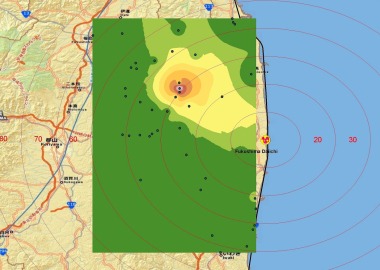ORIGINALLY PUBLISHED: 12.07pm GMT
UPDATE 1: 4.17pm GMT, Addition of IAEA disposition map
Japanese authorities are considering the evacuation of more people in the area around the Fukushima Daiichi nuclear power plant after a more serious spot of radionuclide disposition was identified. Some restrictions on tap water are being lifted but discharges to sea continue.
Notification of this came from the International Atomic Energy Agency (IAEA), reporting the work of its monitoring teams in Japan.
Results from a range of soil samples taken at distances of between 25 kilometres and 58 kilometres from the power plant "indicate a pronounced spatial variability" of the total amounts of iodine-131 and caesium-137 deposited on the ground.
|
| An IAEA interpretation of data from the Japanese Ministry of Education, Culture, Sports, Science and Technology indicates one spot of more serious disposition about 30 kilometres northwest of Fukushima Daiichi. The colours scale down from the highest reading taken to zero |
Levels ranged from 0.2 to 25 megabecquerels per square metre for iodine-131, and from 0.02 to 3.7 megabecquerels per square metre for caesium-137. The higher of these "were found in a relatively small area in the northwest" from the plant. "First assessment indicates that one of the IAEA operational criteria for evacuation is exceeded in Iitate village."
The agency said it advised Japanese authorities, who responded that they were already assessing the situation.
Tap water and food
The most recent measurements of radionuclides in tap water have been below Japanese emergency limits, said the IAEA, adding that most of restrictions previously imposed are being lifted. However, in three places in Fukushima prefecture, tap water is not recommended for infants due to iodine-131 levels above 100 becquerels per kilogram. In one other place there is a wider restriction.
| Tokyo
Radiation levels in the Japanese capital were still only marginally elevated from background levels at less that 0.19 microsieverts per hour. In a range of 32 to 62 kilometres north to northwest from the plant these rose to the range of 0.5 to 6.8 microsieverts per hour. |
While existing controls on food in Fukushima prefecture and some neighbouring areas remain in force, the IAEA said a wide range of tests on other foods in nine prefectures had shown either no detection of iodine-131 and caesium-137 or levels below limits.
Discharge to sea
Concentrations of several radionuclides remain far beyond normal regulatory limits at measuring posts near the plant discharge canals. Levels have risen to their highest yet, after one or two days of slight decrease. Levels of the same isotopes 10 kilometres to the south at the Daini plant are 10-100 times lower but some are still far beyond normal levels.
Further out to sea, the presence of radionuclides in seawater as well as in the air and in dust on the water's surface are being regularly measured. Dose rates from the air are comparable to background radiation on land. One member of staff from the IAEA's Monaco marine laboratory is flying to Japan to join the team assessing marine environment.
Researched and written
by World Nuclear News






_18570.jpg)
_16159.jpg)
_49205.jpg)





